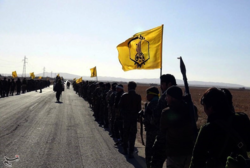
Back المقاتلون الأجانب في الحربين الأهليتين السورية والعراقية Arabic جنگجویان خارجی در جنگ داخلی سوریه و جنگ در عراق Persian Combattants étrangers pendant les guerres civiles syrienne et irakienne French Combattenti ribelli stranieri nella guerra civile siriana Italian Syriëganger Dutch شامی تے عراقی خانہ جنگی وچ غیرملکی جنگجو PNB Combatentes rebeldes estrangeiros na Guerra Civil Síria Portuguese IS-krigare i Syrien och Irak Swedish شامی اور عراقی خانہ جنگی میں غیرملکی جنگجو Urdu
It has been suggested that this article should be split into articles titled foreign fighters in the Syrian civil war and foreign fighters in war in Iraq. (discuss) (February 2022) |
This article needs to be updated. (August 2019) |
Foreign fighters[1] have fought on all four sides of the Syrian Civil War, as well both sides of the War in Iraq. In addition to Sunni foreign fighters, Shia fighters from several countries have joined pro-government militias in Syria, leftist militants have joined Kurdish forces, and other foreign fighters have joined jihadist organizations[2] and private military contractors recruit globally. Estimates of the total number of foreign Sunnis who have fought for the Syrian rebels over the course of the conflict range from 5,000 to over 10,000, while foreign Shia fighters numbered around 10,000 or less in 2013[3] rising to between 15,000 and 25,000 in 2017.[4]
Throughout 2014, with the rise of Islamic State, the Al-Nusra Front, and other groups, their numbers drastically increased[2] and they partnered with and absorbed Syrian rebel groups, both jihadist and non-jihadist. By 2015, foreign jihadists outnumbered Syrian jihadists and other rebels in casualty rolls (16,212 anti-government foreign jihadists were killed in 2015 compared to 7,798 Syrian anti-government rebels killed that same year), a trend that carried over into 2016 (13,297 foreign jihadists and 8,170 Syrian rebels), and 2017 (7,494 foreign jihadists and 6,452 Syrian rebels). However, although the numbers of casualties remained high in this phase, arrivals slowed: according to the United States military, foreign fighters coming to Syria and Iraq in 2013-2015 averaged 2,000 fighters per month, but by 2016, this figure had dropped to less than 500 fighters per month and decreasing.[5] By 2018, the proportion of foreign fighters had far decreased (following heavy losses in the bloody battles of 2015-2017 and various interventions by foreign military forces), and Syrian rebels were once again the majority of anti-government casualties (2,746 foreign jihadists killed compared to 5,852 Syrian rebels).[6][7][8][9]
According to the Syrian Observatory for Human Rights, at least 65,726 anti-government foreign fighters (almost entirely jihadists) were killed in Syria up to May 2020, constituting nearly half of the 138,202 anti-government fighters killed by that point. Additionally, 10,045 foreign fighters on the side of the Syrian government were killed by then (1,700 Lebanese Hezbollah and 8,345 others, including 2,000+ militiamen of Liwa Fatemiyoun) and 264 Russian soldiers and mercenaries.[10]
- ^ Cerwyn Moore & Paul Tumelty (2008) Foreign Fighters and the Case of Chechnya: A Critical Assessment, Studies in Conflict & Terrorism, 31:5, 412-433.
- ^ a b Milton, Daniel; Perlinger, Arie (11 November 2016). Cruickshank, Paul; Hummel, Kristina (eds.). "From Cradle to Grave: The Lifecycle of Foreign Fighters in Iraq and Syria" (PDF). CTC Sentinel. West Point, New York: Combating Terrorism Center: 15–33. Archived (PDF) from the original on 18 June 2020. Retrieved 20 December 2021.
- ^ Lund, Aron. "Who Are the Foreign Fighters in Syria? An Interview With Aaron Y. Zelin". Guide to Syria in Crisis. Carnegie Middle East Center. Retrieved 7 December 2013.
- ^ "Hezbollah Embedded in Syria". Atlantic Council. 2 March 2017. Retrieved 28 September 2020.
- ^ Stewart, Phil. U.S. military softens claims on drop in Islamic State's foreign fighters. Reuters. April 28, 2016. Quote: "U.S. Army Colonel Steve Warren, a Baghdad-based spokesman for the coalition, told Reuters that the official estimate is higher than the one Gersten offered, although he did not provide a precise figure. "We believe the foreign fighter flow was 2,000 at one point and is now down to a quarter or less of that," Warren said."
- ^ "Syria is still bleeding … more than 55,000 thousand persons were killed during the year of 2015 | Syrian Observatory For Human Rights". 31 December 2015. Archived from the original on 31 December 2015.
- ^ "About 60 thousand were killed in 2016 and we still wait for an international trial for the criminals • The Syrian Observatory For Human Rights". 31 December 2016.
- ^ "2017…the year of the military change and the rise of the regime and its allies to head the list of military powers and influences followed by the SDF…and the loss of the opposition and the organization to large spaces of their controlled areas • The Syrian Observatory For Human Rights". 28 December 2017.
- ^ 2018 under different titles...the death of about 23,000 persons, the displacement of hundreds of thousands others, shifts in the influence of the conflicting powers, and regional and international agreements of de-escalation and withdrawal.
- ^ Fourteen years of championing human rights in Syria Syrian Observatory for Human Rights
© MMXXIII Rich X Search. We shall prevail. All rights reserved. Rich X Search
